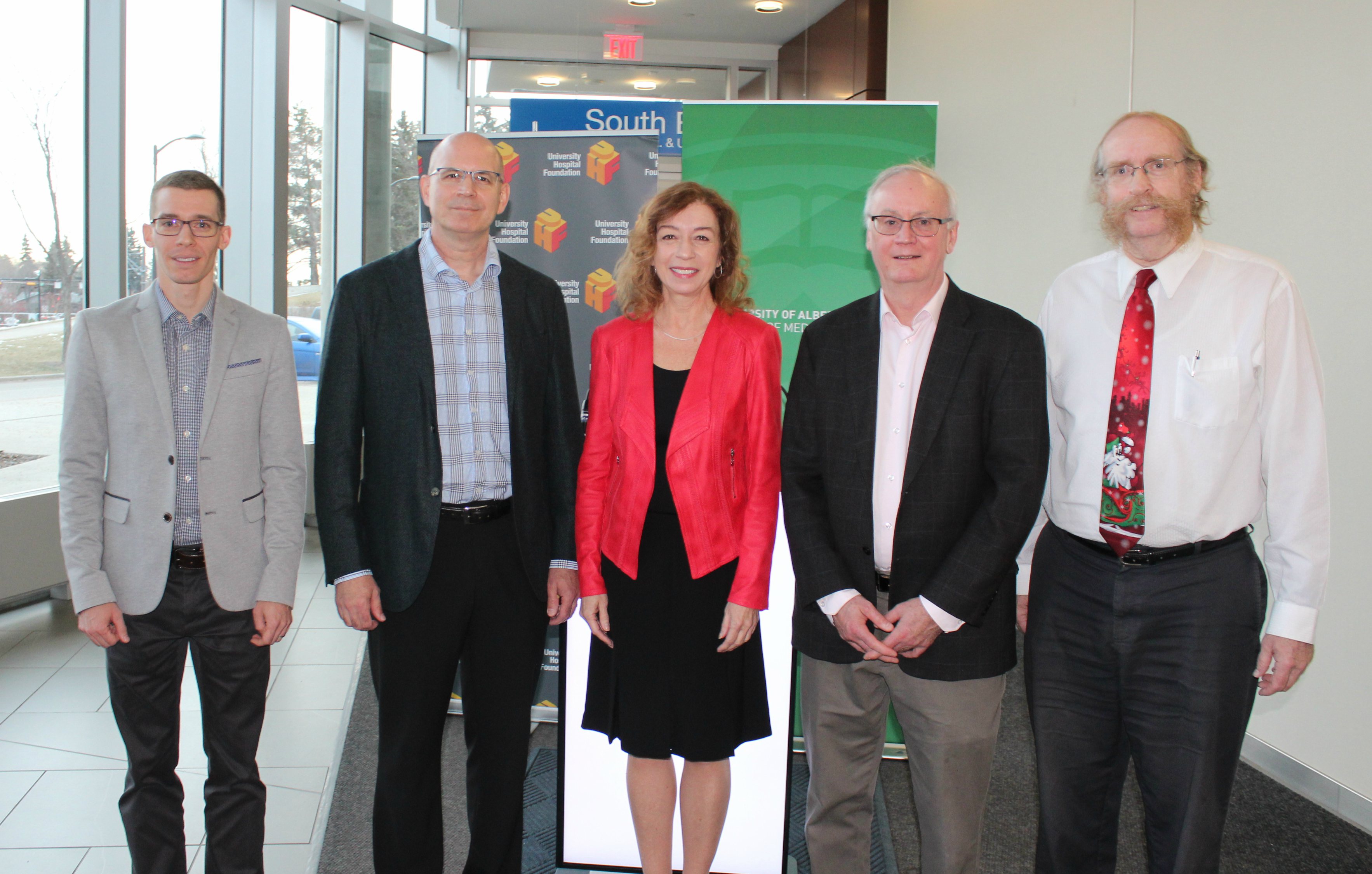
From left to right: Benjamin Adam, Todd McMullen, Beth Ratzlaff, David Evans and Robert Burrell at an event celebrating the past 10 years of the University Hospital Foundation Medical Research Competition.
A point-of-care device that will detect markers of thyroid cancer. An ambulance that allows health care providers to deliver specialized treatment to stroke patients-before they reach the hospital. A test that lets physicians know which kidney transplant patients are at risk of transplant rejection.
These are just a few of the hundreds of projects improving the health of Albertans thanks to the University Hospital Foundation Medical Research Competition (UHFMRC).
In the past 10 years alone, the UHFMRC has supported 169 research projects and 437 researchers at the University of Alberta's Faculty of Medicine & Dentistry, with a total investment of just under $5 million. Since the competition's inception in 1997, the University Hospital Foundation has invested approximately $9.5 million into the program.
However, it's not just the funding that makes the difference-it's the timing. The University Hospital Foundation's Medical Research Competition (UHFMRC) provides seed funding of up to $35,000 to researchers to help get their projects off the ground.
"It's expected that anyone applying for large and long term research grants must supply 'preliminary data' to justify his or her request for funding," said David Evans, vice-dean, research, at the Faculty of Medicine & Dentistry. "Grants from the University Hospital Foundation Medical Research Competition provide important funding that helps hone the quality of research applications, and provides successful applicants with a way of generating this all-important early stage data."
For researchers, this support has a unique impact on their ability to change the future of patient care.
"The University Hospital Foundation has allowed us to explore research that crosses disciplines that are traditionally much more difficult when trying to get resources from traditional provincial and national granting agencies," explained Todd McMullen, a former grant recipient and associate professor of surgery at the University of Alberta.
McMullen and co-investigator Robert Burrell, chair of the U of A's Department of Biomedical Engineering, were awarded a grant in 2012 to identify markers of disease progression in a variety of cancers. Because of the initial seed funding, the pair have been working to develop, test and patent a device that could quickly and efficiently detect aggressive thyroid cancer in patients.
And the support is compounding. Over the past decade researchers awarded UHFMRC grants have gone on to obtain approximately $24.5 million in additional international, national, provincial, and local funding to further their work. A ten-year impact report also showed that 69 per cent of the award recipients published at least one paper on their findings, and 45 per cent of recipients presented their work at a conference.
"The University Hospital Foundation is proud of this fund, and the tremendous impact it has had on patients across Alberta," noted Jim Brown, chair of the University Hospital Foundation's Board of Trustees. "We have the privilege of meeting these researchers; of hearing how the support of our donors has allowed them to pursue their areas of study. And ultimately, the have a transformational impact on patient care."
Thirteen projects have received funding in 2017-among them is research to develop a new test that measures damage in lungs given by donors for transplantation. The project aims to improve existing technology-known as ex-vivo lung perfusion (EVLP)-used to repair damaged lungs, and ultimately lead to more successful lung transplantations.
"One of the goals of EVLP is to repair potential donor lungs that are currently being discarded because they are thought to be too damaged for use in transplantation. However, we do not currently have a good way of knowing when donor lungs treated with EVLP are 'ready' to be used," said Benjamin Adam, project lead and an assistant professor with the U of A's Department of Laboratory Medicine & Pathology.
According to Adam, once developed the test will allow the researchers to better assess which donor lungs are suitable for transplantation. It will also be used to further develop and improve EVLP so that it can be as effective as possible.
"This will ultimately allow for more potential donor lungs to be used for transplantation and for more lung disease patients to be provided with life-saving transplant surgery," said Adam. "Support from the Medical Research Competition will be instrumental in allowing us to get this research off the ground and target larger provincial and national funding opportunities in the future."